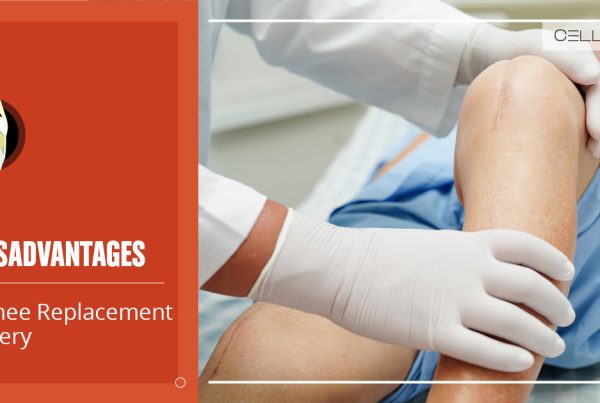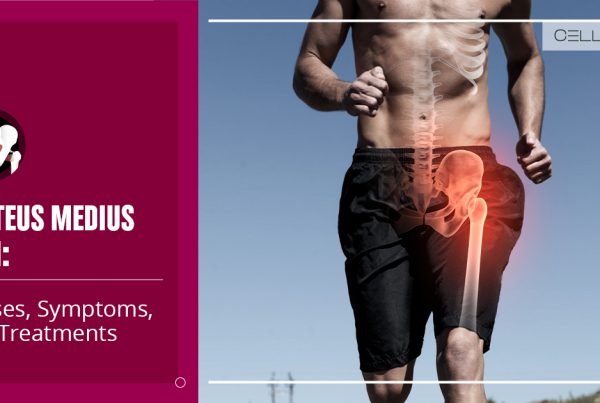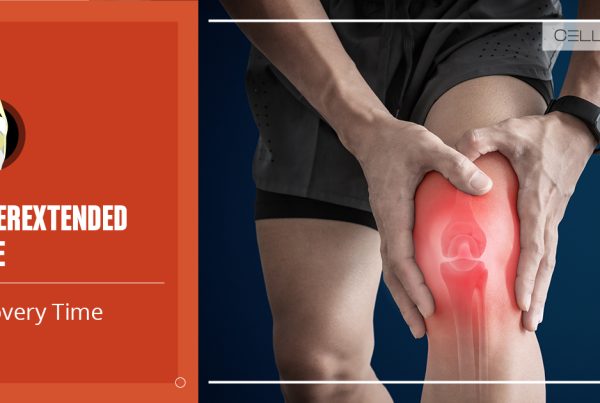Published on: April 15, 2024 | Updated on: January 18, 2025
Knee replacement is among the medical procedures with a high success rate. In most cases, people who undergo a total knee replacement live a mobile and pain-free life.
However, over time, the implant can become loose. As a result, you may experience knee pain and swelling. Doctors recommend a subsequent surgery to remove the original implant and replace it with a new one.
But how would you know if the implant is loose? There are several symptoms that point towards a loose knee replacement. We discuss them below.
Common Symptoms of a Loose Knee Replacement

You can expect to notice some or all of the following symptoms when your knee replacement starts to loosen.
Knee Pain
Knee pain is one of the first symptoms of a loose knee prosthesis. The discomfort typically gets worse when you move, stand, or walk.
Usually, the pain will occur at the site of the knee replacement and may feel sharp or dull. You may also experience stiffness in your knee, making it difficult to bend or straighten your leg. In some cases, the pain may be quite debilitating.
It could impact your daily activities like climbing stairs, walking, or even sitting for extended periods.
Difficulty Walking
As the knee prosthesis begins to loosen, your range of mobility decreases. You may have difficulty walking and performing daily activities without pain or discomfort.
You may also experience a change in your gait, which could lead to limping or dragging your feet.
Swelling
Swelling is a physical sign that your knee prosthesis may be loose. The swelling can occur around the knee or in the entire leg. It is also called water on the knee since the swelling is caused by a buildup of fluid. In some cases, the doctor may drain the fluid to relieve pressure and discomfort. But this is short-term, as the fluid reaccumulates.
Instability
As the knee prosthesis loosens, it may cause instability in your knee joint. You will feel as if your knee cannot bear your weight and may give out or buckle. The condition could be dangerous, as it increases the risk of falls and injuries.
Audible Sounds
If you hear a loud popping or clicking sound when you move your knee, it could be a sign of a loose prosthesis. The sound occurs due to the rubbing of metal components against each other as they loosen.
Redness
Since a loose knee prosthesis causes inflammation, it is common to experience redness around the knee. Your skin may feel warm and tender to touch.
You may use conservative measures, such as applying ice and elevating your leg, to reduce the redness and discomfort. However, these methods only provide temporary relief and do not address the root cause of the problem.
How Is a Loose Knee Replacement Diagnosed?
The diagnosis of a loose knee prosthesis involves several methods, including physical examination and imaging tests. Your doctor may use a bone scan or an X-ray to detect any looseness or bone loss around the prosthesis.
The X-rays show if the implants have shifted from their original position, indicating that they are not securely attached to the bone. Bone scans show if the bone activity has increased in the area.
A knee joint aspiration may also be conducted. In this procedure, the doctor removes some fluid from the knee joint using a needle and tests it for signs of infection or inflammation.
Possible Causes of a Loose Knee Replacement
A loose knee prosthesis may be caused by several reasons, including the following.
Excessive Wear
Knee replacements have a predetermined lifespan. Their longevity depends on several factors:
- Type of implant
- Patient’s age
- Diagnosis
- Fixation type
- Patient’s gender
Typically, knee replacements have a lifespan of 15 to 20 years. After this period, they may start to wear out and become loose.
Fractures
In a knee replacement surgery, the surgeon amputated the thigh bone at the end. Then, they drill a hole into this end of the bone and hammer a metal stud into the patient’s thigh. The knee implant is then attached to this stud.
If the patient’s bone is weak, it may break or fracture around the implant site. Such an occurrence is common in patients with osteoporosis. The result is a loose knee implant.
Infection
If there’s an infection at the site of the knee replacement, the cement around the knee implant that glues the bone and joint may erode. Inflammation can also affect the surrounding muscles and skin. The erosion of cement leads to the loosening of the knee prosthesis.
Rejection
If a patient is allergic to the material the knee implant is made of or the glue used to bond the implant to the bone, their body will launch an immune response. The response will eventually lead to inflammation, redness, and swelling. If the inflammation persists, it may cause the implant to become loose.
Incorrect Implantation
A loose knee replacement might be due to the surgeon’s error during the procedure. If the implant is not properly secured to the bone, it may become loose over time.
Treatment for a Loose Knee Replacement
The major treatment for a loose knee replacement is revision surgery, where the old implant is removed and replaced with a new one. During this procedure, the surgeon also identifies what caused the loosening of the previous implant and addresses it to prevent recurrence.
Orthobiologic Treatments for Knee Problems
People suffering from persistent knee pain now have more treatment options than before, especially with the advancements in regenerative medicine. Platelet-rich plasma therapy (PRP) and cell-based therapy are two of the most popular orthobiologic treatments for knee problems.
At CELLAXYS, we offer these outpatient procedures, allowing you to go home the same day as your treatment.
Platelet-Rich Plasma Therapy (PRP)
Platelets are small cell fragments in the blood that play a critical role in healing. They release 10 different growth factors that help in tissue repair and regeneration.
In PRP therapy, a small amount of blood is drawn from the patient and spun in a centrifuge to separate the platelets from other components. The concentrated platelets are then injected into the affected knee, promoting healing and reducing inflammation.
Cell-Based Therapy
Cell-based therapies use ”autologous” cells, which are taken from the patient’s own body. The two common cell types we use are bone marrow and adipose (fat) tissue-derived cells.
We provide both Minimally Manipulated Adipose Tissue Transplant (MMAT) and Bone Marrow Concentrate (BMC) procedures. In these procedures, we take the cells from your body and inject them into your knee.
Both these regenerative therapies have shown promising results in treating knee pain, even in patients with advanced osteoarthritis. They can reduce pain and improve function, allowing patients to avoid or delay surgery.
Sources
Footnotes
- Cheuk Yin Li, Jordan K, Omar Mohammed Ali, Chung N. Literature review of the causes of pain following total knee replacement surgery: prosthesis, inflammation and arthrofibrosis. EFORT Open Reviews. 2020;5(9):534-543.
- Stotter C, Philipp von Roth. Diagnosis of loosening after knee arthroplasty. Orthopade. 2021;50(12):972-978.
- Zuber TJ. Knee joint aspiration and injection. American Family Physician. 2022;66(8).
- Rand JA, Trousdale RT, Ilstrup DM, Harmsen WS. Factors affecting the durability of primary total knee prostheses. Journal of Bone and Joint Surgery, American Volume. 2003;85(2):259-265. .
- Evans J, Evans JP, Walker R, Blom AW. How long does a knee replacement last? A systematic review and meta-analysis of case series and national registry reports with more than 15 years of follow-up. The Lancet. 2019;393(10172):655-663.
- Saccomanno MF, Sircana G, Masci G. Allergy in total knee replacement surgery: Is it a real problem? World journal of orthopedics. 2019;10(2):63-70.
References
- Swallowing Knee. Mayo Clinic. Accessed 11/12/2023.
- What Does a Pop in Your Knee Mean? Hospital for Special Surgery. Accessed 11/12/2023.
CELLAXYS does not offer Stem Cell Therapy as a cure for any medical condition. No statements or treatments presented by Cellaxys have been evaluated or approved by the Food and Drug Administration (FDA). This site contains no medical advice. All statements and opinions are provided for educational and informational purposes only.
Dr Pejman Bady
Author
Dr. Pejman Bady began his career over 20 years ago in Family/Emergency Medicine, working in fast-paced emergency departments in Nevada and Kansas. He has served the people of Las Vegas as a physician for over two decades. Throughout this time, he has been met with much acclaim and is now the head of Emergency Medical Services in Nye County, Nevada. More about the doctor on this page.
Dr Pouya Mohajer
Contributor
Pouya Mohajer, M.D. is the Director of Spine and Interventional Medicine for CELLAXYS: Age, Regenerative, and Interventional Medicine Centers. He has over 20 years of experience in pain management, perioperative medicine, and anesthesiology. Dr. Mohajer founded and is the Medical Director of Southern Nevada Pain Specialists and PRIMMED Clinics. He has dedicated his career to surgical innovation and scientific advancement. More about the doctor on this page.









